17 Chapter 17: Introduction to Dance
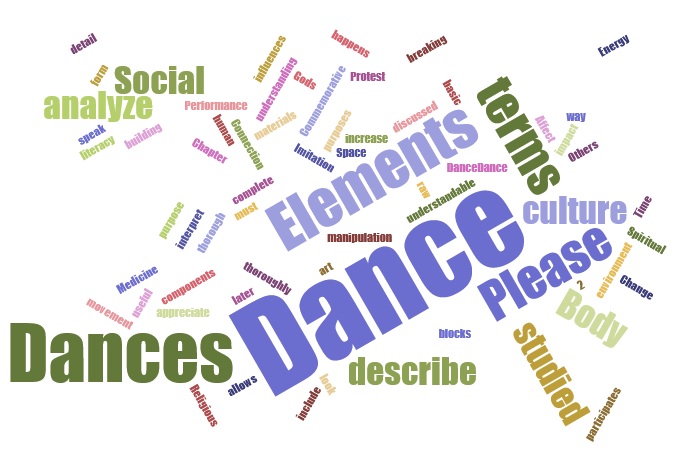
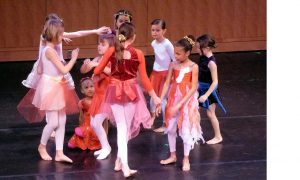
Learning Objectives
With this chapter, you will begin working toward:
- Demonstrating a culturally informed dance aesthetic.
- Identifying the purposes of dance.
Introduction
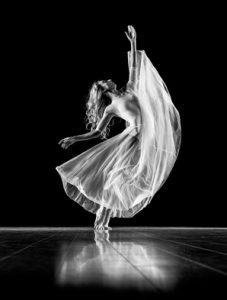
There are many definitions of dance, with people defining dance in their own way. In this chapter, you will consider your personal definition of dance. You will learn the purposes of dance. You will reflect on your experiences and upbringing to determine their influence on your dance aesthetic.
- Poetry, prose, and music are arts that exist in time. It is through the manipulation of rhythm and tempo that these arts are created.
- Painting, sculpture, and architecture are arts that exist in space. It is through the design of space that these arts are created.
- Dance is the only art that is a creation in both time and space.
How do you define dance?
Elements of Dance
Dance can be studied in terms of its raw materials. We can describe movement thoroughly by breaking dance down into its basic components. A complete understanding of the building blocks of dance allows us to analyze, interpret, and speak about dance in a thorough and understandable way. To increase dance literacy and appreciate dance as an art form, we must look at the elements of dance. Through the manipulation of these elements by the human body, dance happens. The elements of dance will be discussed in more detail later in Chapter 18. To describe dance, it is useful to analyze it in terms of these Elements of Dance:
- Body
- Energy
- Space
- Time
Purposes of Dance
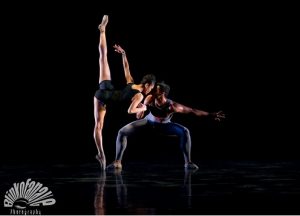
Dance can be studied in terms of its purpose and function within a culture. Cultures impact how people engage with the world, as environmental influences, societal behaviors, and attitudes are intertwined within the development and shaping of dance forms. In this respect, dance is a carrier of culture. The purposes of dance include:
- Religious Dance / Dance to Please the Gods
- Social Dance / Dance to Please Ourselves
- Performance Dance / Dance to Please Others
- Protest Dance / Dance to Affect Social Change
Religious Dance
The earliest dances were likely religious in nature. Some religions embrace dance and use it as a part of their rituals. Other religions have eschewed dance or banned it for a number of different reasons.
The Ancient Greeks and Africans used to dance to solidify their community. Ancient Greek dance, as well as ancient African dance, was divinely inspired. Everyone participated in religious ceremonies as cultivated amateurs and upstanding citizens. A big part of the program was processions and circle dances. The realities of the cosmos ruled the symbolism of the dances, and references to the sun, moon, and constellations figured into the movements.
Types of Religious Dance:
- Dances of Imitation
- Medicine Dances
- Commemorative Dances
- Dances for Spiritual Connection
Dances of Imitation
Particularly in primitive and indigenous cultures, dances of imitation are performed. Dancers imitate animals and natural phenomena to embody specific qualities, like channeling the prowess of an animal. The dances serve various purposes, often promoting favorable outcomes, such as good weather and hunting.
Medicine Dances
Shamans, as spiritual leaders, serve as intermediaries between the human and spirit worlds. Both men and women may be Shamans. The religion is animistic (attributes a spirit to all things), and rituals address medicine, religion, a reverence for nature, and ancestor worship. On the summer solstice, Shamans perform a fire ritual at night. The Shaman drums carry the ancestral spirits of the Shaman.
Commemorative Dances
Dances are created to remember a special day, event, and meaningful moment. Some commemorative dances are very old. Maypole dances have early pagan roots. It is a celebration of the rebirth of spring. The Second Line is a West African form of dance that is a ritual to celebrate the life of the recently departed. After the slaves were brought to the New World, this dance became more of a celebration for parties and Mardi Gras festivals.
Dances for Spiritual Connection
In some cultures, the dancers seek to suppress their ego to find oneness with God. In others, dance may be used to connect with dead ancestors spiritually. Some religions use dance to tell their origin stories and preserve their heritage.
Social Dance
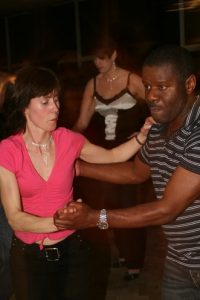
In social dance, we establish a connection with others. Social dance can be sorted into four general categories based on the purpose of the dance.
Types of Social Dance
- Courtship Dances
- Work Dances
- War Dances
- Communal Dances
Courtship Dances
In cultures where marriages are arranged, men and women do not engage in courtship dances. In other cultures, dance may serve as simple flirtation or involve more complex rituals.
Work Dances
Some dances are centered around the work that groups perform. Dances that mimic work routines were used in past times to help build unity and continuity among the crew.
War Dances
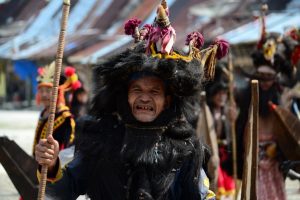
Dance has always been used in conjunction with training for war. Several cultures throughout history used dance as grounds for war preparation. The Greeks participated in pyrrhic dances and used weapons to mimic war tactics in preparation for battle. Capoeira was created by enslaved Africans in Brazil using dance as a guise for practicing fighting. The Māori of Aotearoa / New Zealand dance the Haka as an intimidation tactic that instills warriors with ferocious energy. In South Africa, the Indlamu dance was inspired by Zulu warriors during the Anglo-Zulu wars, was derived from the war dances of amabutho (warriors), and was mainly used to motivate the men before they embarked on their long marches into battles barefoot. Today, cultures continue to pass down these traditions to new generations as tradition.
Communal Dances
Communal dances are often a part of festivals and parties. Dances like springtime’s Maypole dance and the Jewish hora bring a whole community together to share happy times. Communal dances also can be a way for a community to share grief and memories, like the Table of Silence performed at Lincoln Center every year to commemorate 9/11.
Performance Dance
Performance dances are presentational and often are entertainment for an audience. Some amateur dancers put on shows, but there are also professional dancers who attain highly polished technique.
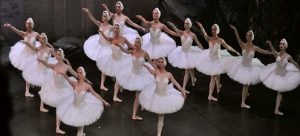
Types of Performance Dance
- Ballet
- Modern
- Tap
- Jazz
- Musical Theater
- Hip Hop
Protest Dance
Protest dance is a response to social situations and the human condition. For slaves of the American South, the cakewalk was a way to mock their white oppressors. Kurt Joos created the modern dance The Green Table after World War I. It reflected hard truths about society and the price of war. Bill T. Jones creates ensemble dances that reveal realities of social injustice. Jo’Artis “Big Mijo” Ratti uses krumping to express his rage and frustration in response to the killing of George Floyd.
Dance Aesthetic
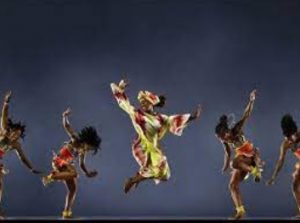
Your aesthetic is that which you find pleasing or beautiful. It is your tastes and preferences, your “likes” and “dislikes.” Your perception of dance will be informed by your aesthetic, which might result in subjective judgments about the dances you see. Therefore, it is essential to acknowledge when these biased opinions emerge to be receptive to the dances you are witnessing and objectively respond to them. By keeping an open mind, we can better our understanding of the uniqueness of each dance as an art form.
Cultural Traditions
Culture is shared values, beliefs, and customs shared among a group of people that contribute to a person’s dance aesthetic. The rhythms of West Africa or Argentina that you grew up listening to can also play a part in shaping rhythmic tastes. Dance is an important way that the lore and traditions of a culture are preserved over time as they are passed down from generation to generation.
Different religions incorporate dance into their worship. Some religions include it as an intrinsic part of their ritual and even link dance to the spiritual experience. Other religions eschew dance altogether. Your religious upbringing and experiences may influence your dance aesthetic.
The program on Safeguarding intangible cultural heritage in formal and non-formal education is a UNESCO initiative, which recognizes that:
- Education plays a key role in safeguarding intangible cultural heritage.
- Intangible cultural heritage can provide context-specific content and pedagogy for education programs and thus act as leverage to increase the relevance and quality of education and improve learning outcomes.
UNESCO considers dance an intangible cultural resource. UNESCO’s Intangible Cultural Heritage division recognizes the following in its Summary Report on education: “The creative process of inter generational transmission is at the center of intangible cultural heritage safeguarding.”
Family Influence
Different generations may prefer different dances. The dances your parents and their friends do are probably different from what you and your friends like. Maybe you have a grandparent who can teach you some older dances.
Media
Do you watch dance on television, in movies, online, in live concerts and shows, at half-time? The many factors of your experiences influence your dance aesthetic.
Personal Response
You will also have a personal response to dance. Do you prefer to move fast or slow, bouncy or gliding, all over the room, or just a little bit? Do you want your dance to demonstrate emotion, or do you prefer a show of virtuosity?
Kinesthetic
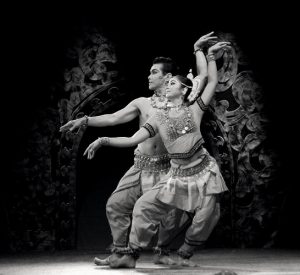
Consider your physical response to dance as you think about your dance aesthetic. Dance is capable of eliciting joy, sorrow, and a wide spectrum of emotions. What aspect of the dance spoke to your personal experiences?
Dance is a beautiful and meaningful stand-alone art. It can be performed without any ancillary arts. But it is also an art that partners successfully with other arts. Costume, scenery, poetry, drama, and music are often a part of the spectacle. As you watch dances this semester, be aware of the music, costumes, and staging that help to lend color and meaning to the dance.
In preserving a culture’s dances, one is able to preserve its stories and other art forms as well.
Summary
People have different ideas about how to define dance. One way to understand dance is to analyze its movement elements: body, energy, space, and time.
We can also study dance in terms of its purpose. Religious dances serve to imitate animals or natural elements, to achieve healing, to commemorate an occasion, or to reach spiritual connection. Social dances can serve in courtship, to find unity in work, unity in war, or camaraderie in the community. Performance dance is created and practiced for presentation to an audience. Western performance dance forms that have developed include ballet, modern, tap, jazz, musical theater, and hip hop. Protest dance can be created to effect social change.
One’s dance aesthetic is shaped and influenced by numerous factors. Family, media, personal response, and kinesthetic response are all contributors to a personal aesthetic.
Resources
Safeguarding intangible cultural heritage in education; UNESCO; https://ich.unesco.org/en/education-01017

